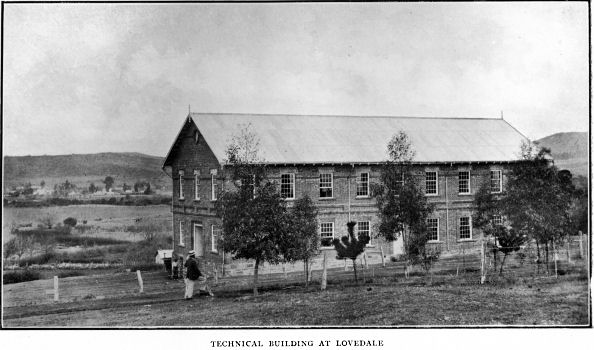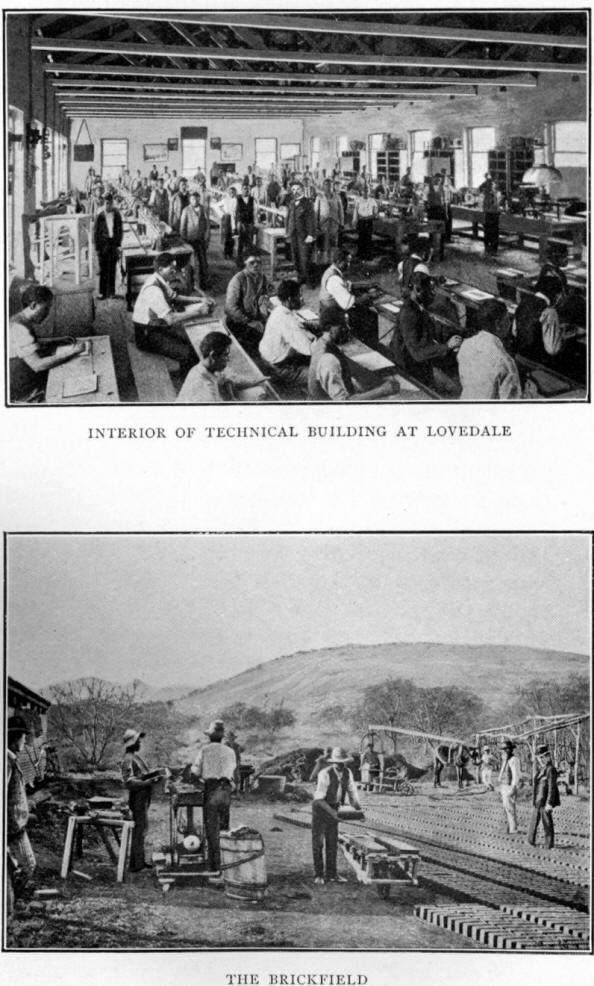fully recognised that man
cannot live by bread alone, and that he cannot live without bread. His
ceaseless aim was to make Lovedale a real Alma Mater, a more bountiful
mother than the average university is or can be. It was his high ambition
to provide for all the needs of the native in body, mind, and soul. He did
not wish him to be a learner for learning’s sake, but to be a learner that
he might be a doer, a maker, a lover of labour, and a man. Some hold that
in undertaking work of this kind the Church has gone off the rails, and
cannot expect to make satisfactory progress. But the early Church relieved
the poor by alms-giving, and surely the modern Church may relieve them by
helping them to earn their own living.
Sir George Grey, the great South
African Pro-Consul, [He was a true friend of the missionaries. In 1890 he
wrote: ‘My heart is filled with gratitude to the missionaries who worked
out so great and noble a success. I earnestly pray that God may still
prosper the labours of such true friends of mankind.’] helped him to
realise some of his aspirations. On his recommendation £3000 was given by
Government to Lovedale for industrial training, while various sums were
given to other missions for the same purpose. After a few years’
experiment the time came for the investigation of results. ‘The
consequence was that at several places these industrial departments
disappeared in a day, like ships foundered at sea. Lovedale, however, was
able to hold steadily on its course.’ In grateful recognition of his help,
Stewart dedicated his Lovedale to Sir George Grey, ‘Under whose
administration and by whose aid the first steps were taken to teach the
arts of civilised life to the native races of South Africa.’
Stewart threw himself heart and soul
into these efforts. He felt that head-work would do little for the native
unless it were wedded to hand-work. In this the missionary was imitating
the Carpenter of Nazareth, whose eighteen silent years in the workshop
have taught the world more than all its other teachers have done or could
have done, the dignity of labour, and provided eternal inspiration for all
who earn their bread in the sweat of the brow.

He thus defined his secular gospel
in the Christian Express:
‘The gospel of work does not save souls, but it saves
peoples. It is not a Christian maxim only, that they who do not work
should not eat; it is also in the end a law of nature and of nations. Lazy
races die or decay. Races that work prosper on the earth. The British
race, in all its greatest branches, is noted for its restless activity.
Its life’s motto is WORK! WORK! WORK! And its deepest contempt is reserved
for those who will not thus exert themselves.’
The natives then had no knowledge of
either the making or the handling of tools, and they could almost as
easily fly as draw a straight line. Their chief achievement was to build a
beehive hut, and that was the work of the women. It was the easiest and
cheapest way of building a house, for it gave a maximum of space for a
minimum of toil, and it avoided the difficulty of managing corners.
Ruskin says that the circle is the
symbol of rest. In South Africa it certainly is the symbol of utter
laziness and savagery. To the question, ‘What are you doing?’ the familiar
answer of the native is:
‘Oh, I am just staying, I am just
sitting.’ That has been his physical and intellectual attitude for untold
ages. His favourite occupation is ‘just sitting.’ Like Voltaire’s trees,
he grows because he has nothing else to do.
The Principal did his best to induce
them to ‘square the circle,’ a feat which he found ‘almost as difficult as
the mathematical problem of similar designation.’ The native pointed to
the patterns in the heavens and asked: ‘Are not the sun and moon circles?
Are they broken up into many pieces?’ ‘The Kafir hut is a hotbed of
iniquity, and as long as such dwellings exist, such evils will continue to
check the progress of the gospel ‘—so wrote the Rev. Tiyo Soga, who had
been reared in one of these huts. Hence the necessity for, and moral value
of, training in the handicrafts. Wagon-making was introduced and
prospered. Lovedale wagons fetched the highest price in the market and
bore the name in conspicuous letters. The introduction of steam power and
machinery in other places injured, this and some other branches of the
industrial work. Stewart had arranged to remedy this defect, but the
Church crisis in Scotland laid an arresting hand upon his plans. He did
not indeed expect the industrial department to pay: his chief end in it,
as in everything else, was to make men. He was dealing with a race as
unprogressive as any known to us. They had developed no art of any kind,
no writing, no philosophy, no money currency, no initiative, and they had
lived very much like animals. Industrial training was essential to their
uplifting.
A technical building was erected,
and the workshops, with equipment, cost over two thousand pounds. It was
then the best-equipped workshop in South Africa, and it had bench
accommodation for seventy-two apprentices. Those admitted have now, after
passing an examination, to serve a three years’ apprenticeship under
competent European teachers.
Lengthened description of each
department is not needful, as the beautiful pictorial illustrations will
at once give an idea of the nature and extent of the work.
After some delays, printing and
bookbinding were begun. It was not easy to induce the natives to join this
department, Kafir experience not showing how a man could live and be
useful by arranging bits of lead in a row. Many tracts, pamphlets,
newspapers, and books have been issued by the mission press. Among these
are the first edition of Dr. Theal’s History of South Africa; Dr.
Kropt’s Kafir-English Dictionary, the standard authority on the
Kafir language; the Kafir Hymn-book, of which many thousands have
been sold; Tiyo Soga’s Kafir translation of the Pilgrim’s Progress;
a series of Kafir Readers; and the Christian
Express.
There is also a Book-store which has
supplied the needs of the neighbourhood and the mission-field. A lady
writes that this Book-store was one of the fairylands of her childhood,
and that she spent her pocket-money in buying books there. Great was her
delight to find out there how books were made.
Dr. Theal, the Historiographer of
Cape Colony, formerly a teacher at Lovedale, had charge of this department
in its early days. He writes: ‘There was no part of the mechanical work
that Dr. Stewart had not made himself master of, little time as he had to
devote to it. If it had been necessary, he could have set in type his own
articles, imposed them, and worked them off on the press. He had not to do
this, but the knowledge that he could have done it, if necessary, gave him
additional power over the workers. . . . To even such humble work as this
did Dr. Stewart give his attention, and he was more than once seen with a
composing-stick in his hand, patiently showing a big black boy how the
spacing ought to be done, and explaining to him the reason why. The result
of such patient care was that many really good plain compositors were
trained at Lovedale, though very few followed that calling after they left
the Institution. Some of them became interpreters in the Government
service, and so turned their knowledge to good account; others directed
their attention to different objects, and two of them are now ordained
clergymen.
‘In just the same way Stewart showed
young men how to plough a straight furrow across a field, for he was
offended with a crooked one; and of the teaching staff at Lovedale, he was
probably alone in his ability to do this.
‘The time will come when volumes on
history and many other subjects will be needed by the black people of
South Africa in their own tongue, but that time is not yet. When it comes,
the readers of the day may look back with gratitude to Dr. Stewart, for no
other man has done so much to prepare their race for it.’
In 1872 a branch office of the
Electric Telegraph Company was opened at Loved ale, and it has proved
self-supporting. Two native operators, the first probably of their race
who had been trained to the use of the instrument, were placed in charge.
Many native boys trained there have been employed at Kimberley, East
London, and other towns. After three years’ trial, the Government General
Manager reported: ‘It affords me pleasure to be able to state that from
the day on which they entered on their duties up to the present, not so
much as the shadow of a complaint has been urged against them.’
A complete Post and Telegraph
Office, with Money Order and Savings Bank, was established at Lovedale
thirteen years ago. It is a recognised office of the Government.

The industrial side of the mission
embraces carpentry, wagon - making, blacksmith work, brick-making,
poultry-farming, bee-keeping, shoe-making, and the planting of trees. A
good deal of work is also done by the lads in keeping in good order the
buildings, the woods, the gardens, the rooms, and the farms. Stewart’s
ever-active mind sometimes contemplated new industries, such as artesian
wells, the growth of osiers, and basket-making.
In the various Industrial
Exhibitions in South Africa, the work done by the Lovedale boys and girls
has received a very large number of medals and certificates of merit. The
girls excel in all kinds of needlework, and many interesting specimens of
it are found in almost every native Christian home.
In 1886 the Rev. Horace Wailer wrote
to Stewart:
‘I was very much delighted with the
Lovedale exhibit in the Colonies’ Exhibition (in London). I confess I
chuckled in my trousers when I noticed how thoroughly you had carried out
your theories of clothing the natives. Ah! for the days of one-half fathom
of blue cloth, and one string of red beads. I am afraid that Mrs. Stewart
and you will relegate them into a very dim and distant past. The
carpentering seemed splendid, and is really a prodigious feat.’
Stewart insisted that whatever was
done at Love-dale must be done thoroughly, and that every pupil must put
heart and conscience into his work and cherish a passion for excellence in
all its details. In him the earthly and heavenly evangels were wedded, and
he was himself the incarnation of all he taught. Upon every remembrance of
him his pupils will be reminded of the necessity for, and the moral
dignity of, labour. It is no wonder that the demand for Lovedale’s trained
artisans has been greater than the supply, and that some of them are
capable of maintaining their ground alongside of Europeans.

